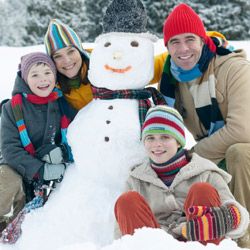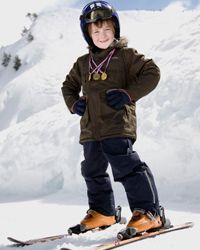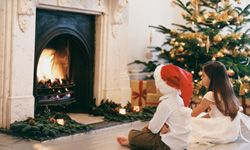 “Sure, that snowman looks friendly now, but just you wait.Jochen Sand/Digital Vision/Getty Images
“Sure, that snowman looks friendly now, but just you wait.Jochen Sand/Digital Vision/Getty Images
Winter can be a magical time. It’s a time when you can build snowmen, watch for reindeer, celebrate a new year and wish for valentines from your true love, all while sipping on delicious hot cocoa. But it’s also a very dangerous time: Reindeer could very well trample everyone in their path, snowmen could come to life and take murderous revenge on humans, and Cupid could leave you with nothing more than a broken heart come Valentine’s Day. Not to mention, that hot cocoa can scald the inside of your mouth.
OK, it’s true that killer snowmen and runaway reindeer aren’t the likeliest winter threats, but just because everyone’s in a festive mood doesn’t mean you can slack on safety. To ensure that your little ones survive the coldest season in one piece, take a look at these five safety tips. They’re best read when you’re snuggled up in a warm blanket with some cocoa — provided that you blow on that hot drink first!
Contents
- Bundle Up
- Winter-proof a Child's Skin
- Be Careful with Those Sleds, Skis and Skates
- Don't Mess with Fire
- Be Ready to Play Inside
5: Bundle Up
Snow is to children as the Bat-Signal is to Batman — a notice that it’s time to get outside and take care of business, be it throwing snowballs (children) or chasing bad guys (Batman). But just as Bruce Wayne wouldn’t leave home without putting on the bat suit, children shouldn’t leave the house without wearing several layers of clothing. These layers, which are more effective than one big winter coat or snowsuit, should include thermal underwear, wool socks, turtlenecks, sweaters, sweatpants and a water-resistant jacket. And don’t forget essential accessories like ski boots, hats, mittens and neck gaiters, which are safer than scarves because they’re less likely to get caught on other objects and cause strangulation. When you’re dressing a baby or a very small child, a good rule of thumb is to put one more layer on him or her than you would put on yourself [source: Lawrence].
Have the kids come back into the house regularly; it’s possible to have so much fun in the snow that you don’t notice that hypothermia is setting in (a key sign is shivering). And whether it’s snowing or not, make sure your child sports some reflective gear when he or she goes outside. In the winter, it gets darker much earlier than normal, so small objects at play will be harder to spot.
Keeping Warm in the Car Seat
Don’t put a baby or small child in his or her car seat already bundled up. The safety straps should be right against the child, and that extra buffer made of heavy clothes could compromise the car seat’s effectiveness. Instead, buckle your child in the car seat, and then place a blanket or jacket on top of the belted child.
4: Winter-proof a Child's Skin
 “He got those medals for remembering the sunscreen.Ashley Jouhar/Digital Vision/Getty Images
“He got those medals for remembering the sunscreen.Ashley Jouhar/Digital Vision/Getty Images
Children have soft, tender skin, and that soft skin’s mortal enemy is winter weather. There are an array of painful problems that can result without proper care. First up: dryness. Not only will cold air dry out skin, so too will the heat blasting indoors. To fight against breakouts of eczema and other dry skin conditions, slather a heavy moisturizer or petroleum jelly on your child. You may want to consider putting a humidifier in a child’s room, particularly if he or she is susceptible to winter nosebleeds. And here’s one thing your kid will probably love — in the winter, kids should bathe only every few days, as frequent hot baths will further dry out skin. While your kids can spend less time in the shower, remember them that they still have to wash their hands religiously; it’s cold and flu season, after all.
Even though it’s winter, you still need to put sunscreen on your kids before they go out to play. That reflection off the fallen snow can burn skin just as easily as a blazing sun. And after children have been playing in the snow, check their skin for possible signs of frostbite. Frostbite, which destroys skin tissue, occurs when the skin turns a light, gray color; the body part in question may also be numb. To treat a mild case, apply something warm to the area. Don’t use something extremely hot; even lukewarm water will heat the area adequately. If the frostbitten area doesn’t respond, then the child may need medical attention.
3: Be Careful with Those Sleds, Skis and Skates
Winter sports, like sledding, skiing and ice skating can be tons of fun, but they can also be extremely dangerous. While a sprained knee or a broken wrist would certainly put a damper on the winter season, a head injury could result in everything from learning and memory problems to coma and death. For that reason, wearing a helmet is encouraged for all of these activities.
The image of kids whizzing downhill on a sled is iconic; even Norman Rockwell used the subject for his paintings. But this historical pastime has gotten more dangerous with the rise of cheap, plastic sleds. While these sleds may go faster, they don’t offer the steering or braking control that older wooden ones do. Even worse are objects not meant to be used as sleds, such as plastic bags or cafeteria trays. To ensure safety, use a proper sled in an open area free of trees and moving traffic. Supervise children at all times, and keep an eye on children who may be standing in the pathway of a runaway sled.
Kids who get their kicks on skis need at least one professional lesson before hitting the slopes, and they should never ski alone. Budding figure skaters and hockey stars should wear wrist guards and lace their skates tightly to provide ankle support.
With any of these sports, children should use equipment that’s made for their size and skill level. They shouldn’t chew gum or eat candy while playing, and no matter what activity your children love, make sure they take regular rest breaks. Injuries are more likely as kids tucker out.
2: Don't Mess with Fire
 “A winter fire is cozy, but mind the children while it burns.Lottie Davies/Digital Vision/Getty Images
“A winter fire is cozy, but mind the children while it burns.Lottie Davies/Digital Vision/Getty Images
Once your kids come in from a long day of sledding and building snowmen, they’ll probably want to relax in front of a hot fire, or at least enjoy some central heat. No matter how you heat your home, fires are a huge risk for families in the winter months. Before building a fire, install a smoke alarm on every floor of the home; you may also need a carbon monoxide detector, as this silent killer gives no warning of its presence.
If you use a fireplace, be sure that the screen is firmly attached, not free-standing, as a child could knock it over. You may want to install an extra fireplace gate if you have particularly adventurous tots on your hands, but regardless of how well-guarded the fireplace is, you should never leave a child unattended in a room where a fire is burning. Keep matches and lighters out of children’s reach.
Thousands of fires each year are caused by space heaters. Don’t let a child get too close to a space heater. In fact, don’t let anything get too close to a space heater — it should always be at least 3 feet (91 centimeters) away from particularly flammable things like curtains, bedding or furniture [source: Debrovner]. These devices should be turned off when you leave the room and when you go to sleep.
Even if you see yourself as the king or queen of fire safety, create a fire safety plan for your family and have fire drills for your children.
1: Be Ready to Play Inside
No matter how well bundled a child is, and no matter how much that new sled wants a workout, children should not play outside during snowstorms. And even if there’s no snow on the ground, there may be a point when it’s just too cold to go outdoors. You don’t want your child to run recklessly through the house, nor do you don’t want him or her to sit in front of the television all day, munching on holiday candy. That’s why it’s important to have safe but active indoors activities on hand for the winter.
While it’s always a good idea to have board games and art supplies on hand for those times when your family is snowed in, make an effort to think of ways that your children can safely move around when they can’t get outside. Some ideas include playing dress-up, dance parties and beanbag tosses. Scavenger hunts and obstacle courses can be fun, too, as long as kids are limited to a defined, safe space. If it’s safe to drive, take your kids to a local YMCA or indoor gym for fun and games.
Lots More Information
Related HowStuffWorks Articles
- Top 5 Summer Safety Tips for Kids
- How Halloween Safety Works
Sources
- Bilich, Karin A. "Fending Off Frostbite." Parents. (Oct. 26, 2009)http://www.parents.com/kids/safety/outdoor/fending-off-frostbite/
- Debrovner, Diane. "Help Kids Play It Safe During the Winter Months." NBC. Nov. 30, 2006. (Oct. 26, 2009)http://www.msnbc.msn.com/id/15979350/
- DeNoon, Daniel J. "Kids’ Sleds Fun but Not Harmless." WebMD. Nov. 19, 2003. (Oct. 26, 2009)http://www.webmd.com/parenting/news/20031119/kids-sleds-fun-not-harmless
- Frankenfield, Gay. "Avoidable Injuries Continue in Winter Sports." WebMD. March 6, 2000. (Oct. 26, 2009)http://www.webmd.com/news/20000306/avoidable-injuries-continue-in-winter-sports
- Halperin, Rory. "Winter Sports Safety." Parents. November 2003. (Oct. 26, 2009)http://www.parents.com/fun/activities/outdoor/winter-sports-safety/
- Hatfield, Heather. "Winter Wonderland of Safety Tips." WebMD. (Oct. 26, 2009)http://men.webmd.com/features/winter-wonderland-of-safety-tips
- Herszenhorn, David M. "Thrills, Spill sand More Cries of Sled Injuries; Non-Steer Plastic Replaces Flexible Flyer on the Hills." New York Times. Feb. 23, 2001. (Oct. 26, 2009)http://www.nytimes.com/2001/02/23/nyregion/thrills-spills-more-cries-sled-injuries-non-steer-plastic-replaces-flexible.html
- Lawrence, Star. "Preparing Your Family for Winter Weather." WebMD. (Oct. 26, 2009)http://www.webmd.com/parenting/features/preparing-family-winter-weather
- McCarthy, Claire. "On Call Kids’ Health." Parenting. December 2005/January 2006.
- "Safety worries over time changes." BBC. Oct. 23, 2009. (Oct. 26, 2009)http://news.bbc.co.uk/cbbcnews/hi/newsid_8320000/newsid_8322900/8322971.stm
- Skolnik, Deborah. "Fun Winter Activities." Parents. (Oct. 26, 2009)http://www.parents.com/fun/activities/outdoor/fun-winter-activities/
- Stout, Hilary. "Why Kids Shun Winter Coats." Wall Street Journal. Jan. 27, 2005.
- Turner, Beth. "Winter Weather Safety Guide." Parents. Dec. 21, 2005. (Oct. 26, 2009)http://www.parents.com/baby/safety/outdoor/winter-weather-safety-guide/#
- "Winter Safety Tips." American Academy of Pediatrics. November 2008. (Oct. 26, 2009)http://www.aap.org/advocacy/releases/decwintertips.cfm
- Zerello, Amy. "Keep Kids Safe This Winter: 10 Smart Tips." Reader’s Digest. (Oct. 26, 2009)http://www.rd.com/living-healthy/kids-winter-safety-tips/article21924.html


